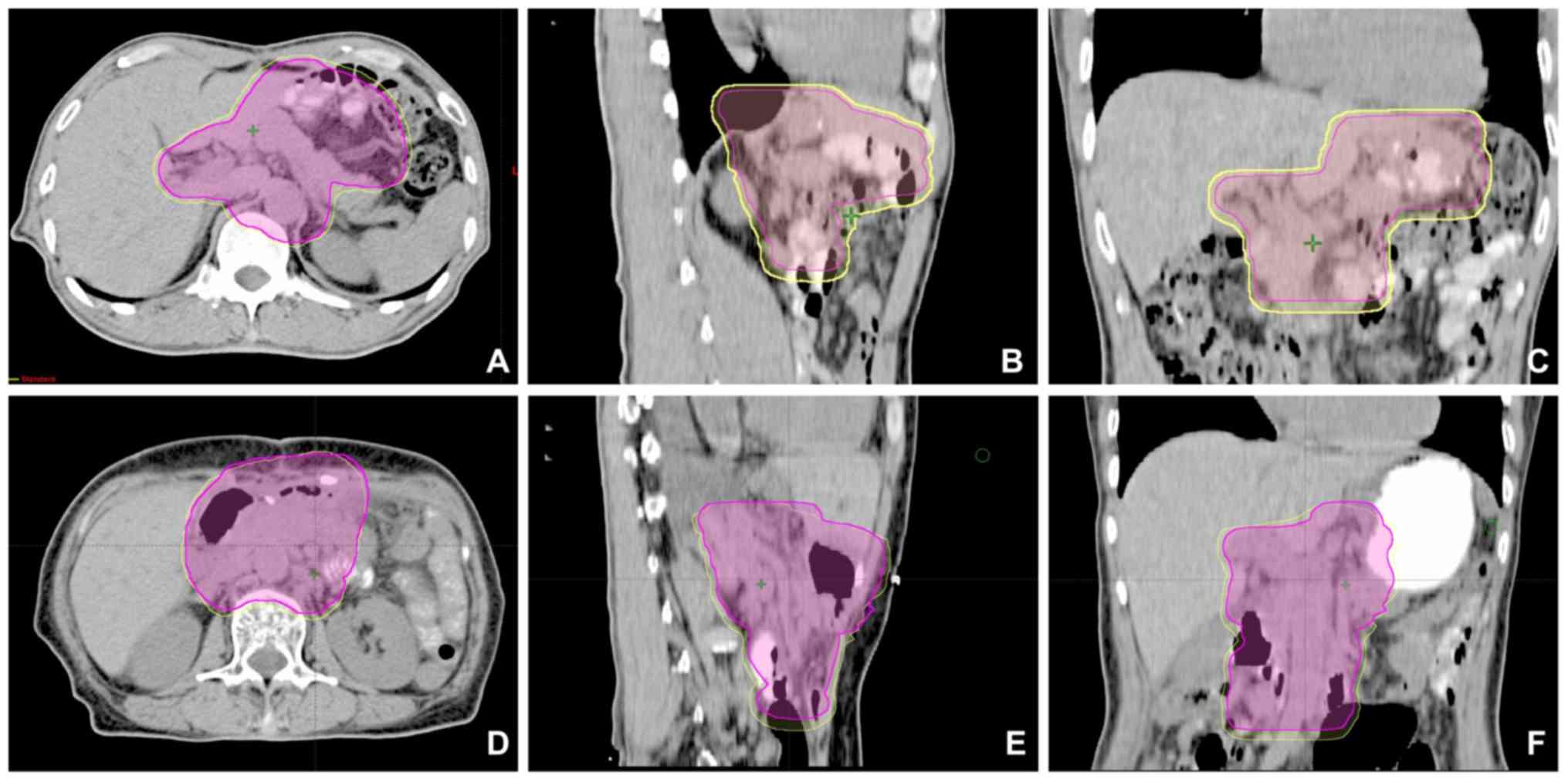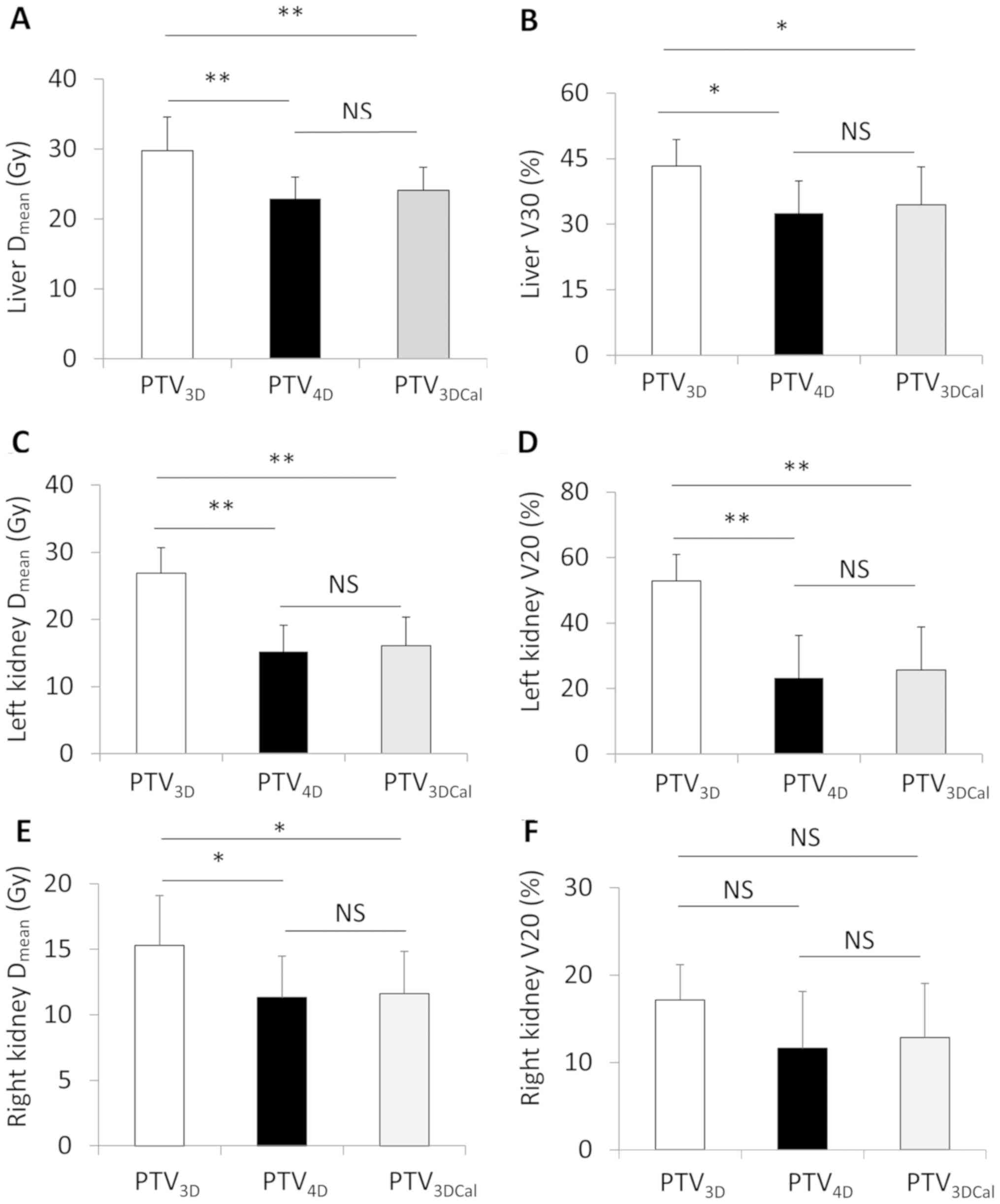|
1
|
Torre LA, Bray F, Siegel RL, Ferlay J,
Lortet-Tieulent J and Jemal A: Global cancer statistics, 2012. CA
Cancer J Clin. 65:87–108. 2015. View Article : Google Scholar : PubMed/NCBI
|
|
2
|
Ferlay J, Shin HR, Bray F, Forman D,
Mathers C and Parkin DM: Estimates of worldwide burden of cancer in
2008: GLOBOCAN 2008. Int J Cancer. 127:2893–2917. 2010. View Article : Google Scholar : PubMed/NCBI
|
|
3
|
Chen W, Zheng R, Baade PD, Zhang S, Zeng
H, Bray F, Jemal A, Yu XQ and He J: Cancer statistics in China,
2015. CA Cancer J Clin. 66:115–132. 2016. View Article : Google Scholar : PubMed/NCBI
|
|
4
|
Kim YS, Park SH, Ahn SD, Lee JE, Choi EK,
Lee SW, Shin SS, Yoon SM and Kim JH: Differences in abdominal organ
movement between supine and prone positions measured using
four-dimensional computed tomography. Radiother Oncol. 85:424–428.
2007. View Article : Google Scholar : PubMed/NCBI
|
|
5
|
Hallman JL, Mori S, Sharp GC, Lu HM, Hong
TS and Chen GT: A four-dimensional computed tomography analysis of
multiorgan abdominal motion. Int J Radiat Oncol Biol Phys.
83:435–441. 2012. View Article : Google Scholar : PubMed/NCBI
|
|
6
|
Macdonald JS, Smalley SR, Benedetti J,
Hundahl SA, Estes NC, Stemmermann GN, Haller DG, Ajani JA,
Gunderson LL, Jessup JM and Martenson JA: Chemoradiotherapy after
surgery compared with surgery alone for adenocarcinoma of the
stomach or gastroesophageal junction. N Engl J Med. 345:725–730.
2001. View Article : Google Scholar : PubMed/NCBI
|
|
7
|
Jiang SB: Radiotherapy of mobile tumors.
Semin Radiat Oncol. 16:239–248. 2006. View Article : Google Scholar : PubMed/NCBI
|
|
8
|
De Ruysscher D, Faivre-Finn C, Nestle U,
Hurkmans CW, Le Péchoux C, Price A and Senan S: European
organisation for research and treatment of cancer recommendations
for planning and delivery of high-dose, high-precision radiotherapy
for lung cancer. J Clin Oncol. 28:5301–5310. 2010. View Article : Google Scholar : PubMed/NCBI
|
|
9
|
Li FX, Li JB, Zhang YJ, Liu TH, Tian SY,
Xu M, Shang DP and Ma CS: Comparison of the planning target volume
based on three-dimensional CT and four-dimensional CT images of
non-small-cell lung cancer. Radiother Oncol. 99:176–180. 2011.
View Article : Google Scholar : PubMed/NCBI
|
|
10
|
Wang L, Hayes S, Paskalev K, Jin L,
Buyyounouski MK, Ma CC and Feigenberg S: Dosimetric comparison of
stereotactic body radiotherapy using 4D CT and multiphase CT images
for treatment planning of lung cancer: Evaluation of the impact on
daily dose coverage. Radiother Oncol. 91:314–324. 2009. View Article : Google Scholar : PubMed/NCBI
|
|
11
|
Jang JW, Brown JG, Mauch PM and Ng AK:
Four-dimensional versus 3-dimensional computed tomographic planning
for gastric mucosa associated lymphoid tissue lymphoma. Pract
Radiat Oncol. 3:124–129. 2013. View Article : Google Scholar : PubMed/NCBI
|
|
12
|
Japanese Gastric Cancer Association:
Japanese classification of gastric carcinoma: 3rd English edition.
Gastric Cancer. 14:101–112. 2011. View Article : Google Scholar : PubMed/NCBI
|
|
13
|
Matzinger O, Gerber E, Bernstein Z,
Maingon P, Haustermans K, Bosset JF, Gulyban A, Poortmans P,
Collette L and Kuten A: EORTC-ROG expert opinion: Radiotherapy
volume and treatment guidelines for neoadjuvant radiation of
adenocarcinomas of the gastroesophageal junction and the stomach.
Radiother Oncol. 92:164–175. 2009. View Article : Google Scholar : PubMed/NCBI
|
|
14
|
International Commission on Radiation
Units and Measurements I: Prescribing, recording, and reporting
photon beam therapy (Supplement to ICRU Report 50). ICRU Report.
62:1999.
|
|
15
|
Yamashita H, Okuma K, Takahashi W, Sakumi
A, Haga A, Ino K, Akahane M, Ohtomo K and Nakagawa K:
Four-dimensional measurement of the displacement of metal clips or
postoperative surgical staples during 320-multislice computed
tomography scanning of gastric cancer. Radiat Oncol. 7:1372012.
View Article : Google Scholar : PubMed/NCBI
|
|
16
|
Matoba M, Oota K, Toyoda I, Kitadate M,
Watanabe N and Tonami H: Usefulness of 4D-CT for radiation
treatment planning of gastric MZBCL/MALT. J Radiat Res. 53:333–337.
2012. View Article : Google Scholar : PubMed/NCBI
|
|
17
|
Xi M, Liu MZ, Li QQ, Cai L, Zhang L and Hu
YH: Analysis of abdominal organ motion using four-dimensional CT.
Ai Zheng. 28:989–993. 2009.(In Chinese). PubMed/NCBI
|

















